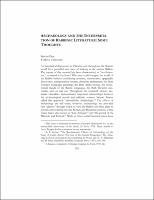Please use this identifier to cite or link to this item:
https://hdl.handle.net/20.500.12202/5831| Title: | Archaeology and the interpretation of rabbinic literature : some thoughts. |
| Authors: | Fine, Steven Kraus, Matthew A |
| Keywords: | archaeology Rabbinical literature midrashim rabbinics |
| Issue Date: | 2006 |
| Publisher: | Piscataway, NJ : Gorgias Press |
| Citation: | Fine, Steven. Archaeology and the interpretation of rabbinic literature : some thoughts. (2006). How should rabbinic literature be read in the modern world? 1st ed. Ed. Mathew A. Kraus. Piscataway, NJ : Gorgias Press. |
| Series/Report no.: | Judaism in context;4 |
| Abstract: | The creative interaction of rabbinic texts with archaeology is fraught with both promise and danger. Building bridges between silent artifacts and the “Oral Torah” requires great care that neither type of evidence dominates the other. On the one side, the urge to find rabbinic parallels to archaeological sources can lead to a kind of “parallelomania”. On the other, a scholarly nihilism has developed that minimalizes the significance of rabbinics for understanding the archaeological record—and vice versa. I will explore just a few of the ways that archaeology can be used to better understand rabbinic literature. My focus will be on non-legal material. I begin by illustrating ways that archaeology can inform the interpretation of rabbinic texts. I then turn to the use of archaeology in the discovery of previously unknown midrashim, describing some of the more significant discoveries of midrash “in stone.” My focus will be on discoveries in the Land of Israel. (From introductory paragraphs) |
| Description: | Book chapter |
| URI: | https://hdl.handle.net/20.500.12202/5831 |
| ISBN: | 9781593332143 1593332149 |
| Appears in Collections: | Bernard Revel Graduate School of Jewish Studies (BRGS): Faculty Publications |
Files in This Item:
| File | Description | Size | Format | |
|---|---|---|---|---|
| Fine ARCHAEOLOGY_AND_THE_INTERPRETATION_OF_RA-1.pdf | 432.03 kB | Adobe PDF |  View/Open |
This item is licensed under a Creative Commons License

